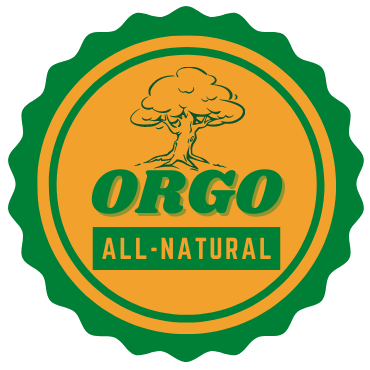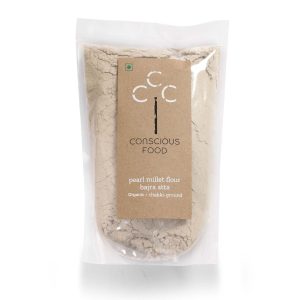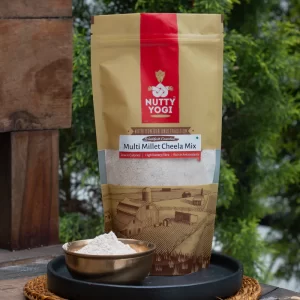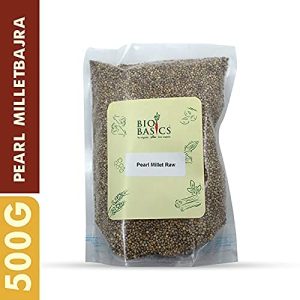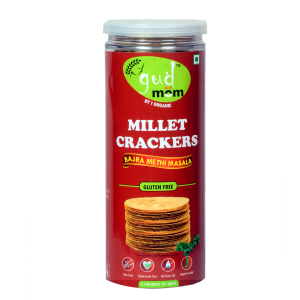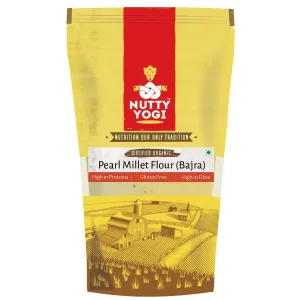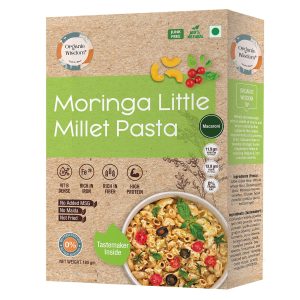What is Bajra (Pearl Milets)?
Bajra, also known as pearl millets, is a drought-resistant crop widely grown in the Sahel Region of Africa and parts of India. Bajra is mainly a variety of millets, accounting for almost 50% of total millets production worldwide.
This grain can be grown in areas where water scarcity is abundant, low soil fertility, high temperature and low moisture. Bajra (pearl millets) is mainly a summer annual crop even well suited for soil with high salinity and low pH. They grow in many shades of bluish-purple, brown, yellow, grey, and white.
Bajra has a long history of being cultivated in the Indian and African subcontinent since prehistoric times. But people forgot to consider Bajra as a super nutritious superfood, thanks to the modern science that has brought back its lost glory before us.
In this read, we would like to provide you with an overview of Bajra and its health benefits.
Bajra Nutritional value per 100g
Bajra (pearl millets) is a staple diet for millions, especially in areas with difficult growing conditions. This superfood grain is a compact source of protein, fibre, vitamins and nutrients including zinc, iron, and magnesium. Like many other millet variants, Bajra is also a power-packed food. Let’s have a look at the nutritional content of 100 grams of Bajra.
| Calories: 387 |
| Protein: 11 grams |
| Fat: 4.2 grams |
| Carbs: 73 grams |
| Crude Fiber: 1.2 grams |
| Sodium: 5 mg |
| Calcium: 8 mg |
| Iron: 3 mg |
| Magnesium: 124 mg |
| Phosphorus: 280 mg |
| Potassium: 195 mg |
| Zinc: 1.7 mg |
| Copper: .75 mg |
| Manganese: 1.6mg |
| Selenium: 2.7mcg |
10 Nutritional Health Benefits of Bajra (Pearl millets )
Lowers high blood sugar
Bajra, or pearl millet, is a superfood that is often recommended to reduce high blood sugar. This is because Bajra has a low glycemic index, high fibre content, and rich magnesium levels. These are the properties that slow carbohydrate digestion and glucose absorption, preventing spikes in blood sugar. Bajra is a healthier choice for those with diabetes since it has both soluble and insoluble fibres, which take longer to digest and don’t immediately boost blood sugar.
Maintains blood pressure
Bajra (pearl millet) is a healthy grain that not only keeps a check on blood pressure but also maintains cardiovascular health. This nutrition superfood is a great potassium and magnesium source that helps the body rid itself of excess salt. It can help to decrease high blood pressure as well. Bajra’s antioxidants reduce inflammation and oxidative stress, contributing to lower blood pressure.
Gluten-free diet
Gluten is a kind of protein found in wheat, it causes allergic reactions for many. Bajra is naturally a gluten-free superfood, thus it stays in the diet for those who have celiac disease or gluten sensitivity. As such, it’s an excellent substitute for wheat for individuals because that provides essential nutrients like fibre, magnesium, potassium and antioxidants without causing adverse reactions in individuals who need to avoid gluten.
Beneficial for weight loss
Bajira (pearl millets) is rich in soluble and insoluble fibres, which draw excess cholesterol from our bile and eliminate it from our bodies. Besides that, this grain contains a good amount of fibre which gives a feeling of satiety. It refrains you from untimely munching. By preventing the body from accumulating excess fat in the form of cholesterol, Bajra aids in weight reduction. It contains beneficial fatty acids that help our bodies to replace harmful fatty acids.
Healthy bones
Bajra has all the micronutrients that are needed for healthy bones. This grain has a good amount of iron, calcium, and magnesium – all are essential for bone strength and density. Bajra is also a good source of phosphorus, crucial for maintaining bone structure and strength. Bajra promotes overall bone health and reduces the risk of bone-related ailments. Explore Orgo All-Natural to know 1 kg bajra price online
Prevents anaemia
It helps manage and prevent iron deficiency anaemia because of its high iron and folic acid content. Both iron and folic acid play major roles in blood formation. For this reason, Bajra is an essential part of the diet of everyone who suffers from anaemia, including women, children, and those who don’t.
Good for your kiddos
Bajra is an all-in-one superfood that is appropriate for young ones. Its numerous health advantages validate its reputation as a nutritious snack for picky eaters and an excellent supper to begin your child’s weaning process. Bajra is also a good source of energy due to its complex carbohydrates, providing sustained fuel for active kids.
Bajra for pregnant women
Bajra offers numerous health benefits for pregnant women. It is an incredible pregnancy-friendly meal since the expectant mother takes iron supplements to prevent anaemia and support the increased blood volume during pregnancy. Adding Bajra (pearl millets) to her diet would undoubtedly help her meet her daily needs for folic acid and iron.
Beneficial for constipation
As we’ve already covered, Bajra, which has a lot of soluble and insoluble fibre, is an excellent prebiotic for the healthy bacteria in your stomach. Fibre adds bulk to stool, making it easier to pass through the digestive tract. Your stools’ insoluble fibre adds to their volume and eases constipation. Its fibre content also promotes the growth of beneficial gut bacteria, making it an overall digestive healthy superfood.
Reduces the chance of stomach ulcers
It not only eases constipation but also stops stomach ulcers from producing acidity. This grain lessens the chances that elevated gut acidity may result in ulcer formation. It contains compounds like phenolic acids and flavonoids, which possess antioxidant properties that help protect the stomach lining from damage caused by oxidative stress and inflammation.
Bajra for weight loss
Bajra might bring you a prolonged feeling of fullness since it is difficult to digest and contains complex carbohydrates. It thereby prevents overeating between meals and provides you with a steady stream of energy. Untimely munching is a reason behind weight gain, but Bajra successfully keeps you away from that.
This energy-dense, low-calorie superfood also has a high amount of insoluble fibre, which aids in burning fat. Thus, you may benefit from Bajra’s weight-loss properties by including it in your diet in the form of khichdi, porridge, or roti. Visit Orgo All-Natural to know 1 kg bajra price online.
Bajra for skin
Bajira’s anti-inflammatory and antioxidant properties provide several benefits for our skin and hair. It can reduce fine lines and wrinkles, which are signs of early ageing.
Its vitamin E and phenolic compounds help our skin to protect the skin from oxidative stress caused by free radicals. This protection can prevent premature ageing signs like wrinkles, fine lines, and age spots.
Bajra (pearl millets) is also a good source of various vitamins and minerals, including zinc, magnesium, and selenium – essential for maintaining healthy skin.
The fibre content in Bajra aids in digestion and promotes the elimination of toxins from the body. Moreover, Bajra reduces blood sugar, the reason behind skin acne, eczema, or psoriasis.
General hydration, which is essential to maintain skin suppleness and promote a healthy sheen, is another benefit of Bajra.
Bajra for diabetes
We have discussed earlier that Bajra is beneficial for individuals with diabetes due to its low glycemic index (GI) and high fibre content. Foods with a low GI are digested and absorbed more slowly. This causes a gradual rise in blood sugar levels.
The fibre in Bajra promotes satiety and keeps fuller for quite a long duration. This is another health perk of Bajra, especially in weight management. Excess body weight is a risk factor for type 2 diabetes.
Individuals with diabetes need to monitor their portion sizes and overall carbohydrate intake, then they should step forward to make Bajra a part of their balanced diet.
Ways to consume Bajra (pearl millets)
Bajra is a staple food that can be consumed in several ways. Some we are mentioning here:
- Bajra Roti: It is probably the most common way to consume Bajra. Bajra roti or flatbreads are made from Bajra flour. It is often enjoyed with vegetables or curries.
- Bajra Khichdi: you can replace regular rice with Bajra as it contains less carbohydrates. You can add various vegetables or lentils with Bajra while cooking khichdi.
- Bajra Porridge: Porridge, malt or kanji is a healthy breakfast option enjoyed during hot summer days. It is cooked with milk or water and then added to some sort of sweetener.
- Bajra Ladoo: yes, Bajra can be consumed in such a delicious way. These sweet ladoos are made from Bajra flour, ghee, and jaggery.
- Bajra Upma: It’s a savoury dish similar to semolina upma, made with vegetables and spices.
Bajra names in India
In India, Bajra is known as Pearl millet in English.
In Telugu, it is called Sajja,
In Tamil, it is referred to as Kambu, and
In Kannada, it is known as Sajje.
Conclusion
Bajra, or pearl millet, is a superfood that you must include in your diet since it has so many health benefits. According to research, millet is a versatile grain that can help maintain a healthy, balanced lifestyle. We hope you got to know enough about Bajra’s benefits and will be very interested in incorporating this into your meal. Check out for 1kg Bajra price online at Orgo All-Natural. We will be happy to help you start eating more healthfully and leading a greener lifestyle.
